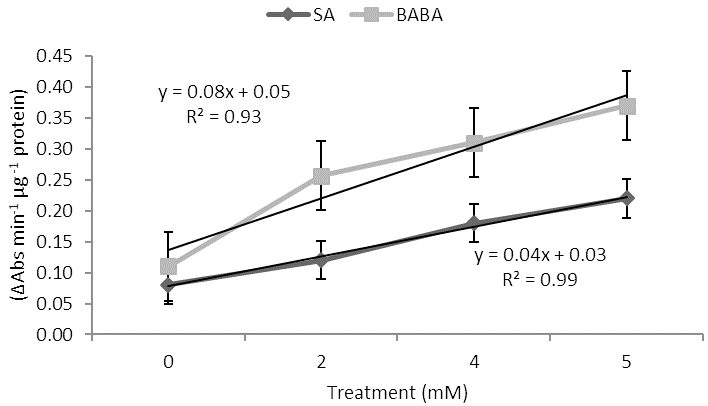Management of Late Blight and Sucking Insect Pests of Potato with Application of Salicylic Acid and β-aminobutyric Acid under Greenhouse Conditions
Management of Late Blight and Sucking Insect Pests of Potato with Application of Salicylic Acid and β-aminobutyric Acid under Greenhouse Conditions
Muhammad Usman Ghazanfar1, Waqas Raza1*, Waqas Wakil2,3, Imtiaz Hussain4 and Misbah Iqbal Qamar1
Effect of SA and BABA dose on percent protection against Phytophthora infestans on potato. Bars with the same letter are not significantly different, P = 0.05, Tukey’s HSD test.
Effect of SA and BABA dose on lesion size against Phytophthora infestans on potato. Bars with the same letter are not significantly different, P = 0.05, Tukey’s HSD test.
Effect of SA and BABA dose on numbers of lesions against Phytophthora infestans on potato. Bars with the same letter are not significantly different, P = 0.05, Tukey’s HSD test.
Percent mean mortality of potato aphid, thrips and whitefly on potato leaves treated with aqueous solutions of SA and BABA. Bars with the same letter are not significantly different, P= 0.05, Tukey’s HSD test.
Peroxidase (POX) activity in potato leaves after treatment with SA or BABA. Assays of POX activities performed 15 days post-inoculation. Bars with the same letter are not significantly different, P= 0.05, Tukey’s HSD test.
Polyphenol oxidase (PPO) activity in potato leaves after treatment with SA and BABA. Assays of PPO activity performed 15 days post-inoculation. Bars with the same letter are not significantly different, P = 0.05, Tukey’s HSD test.













